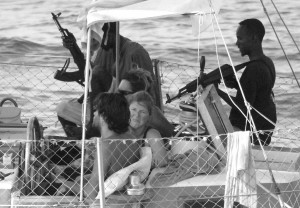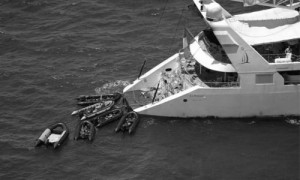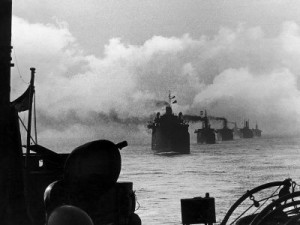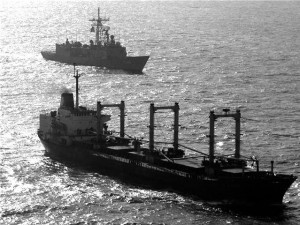Sailing Through the Pirate Zone
 This morning November 2nd Reuters reported a potential hijacking of a yacht in the Indian Ocean with three British crew onboard, only ten days after the first anniversary of the kidnapping of the Chandlers, a British couple who were travelling on their yacht from the Seychelles to Tanzania and remain captive to this day.
This morning November 2nd Reuters reported a potential hijacking of a yacht in the Indian Ocean with three British crew onboard, only ten days after the first anniversary of the kidnapping of the Chandlers, a British couple who were travelling on their yacht from the Seychelles to Tanzania and remain captive to this day.
Between 2008 and 2009, the yachts and crews of the Tanit, Serenity, Indian Ocean Explorer, Lynn Rival, Le Ponant, Rockall and Carre D’As IV were captured by pirates in the Gulf of Aden and Indian Ocean, whilst the Alondra and Tactical Directions allegedly came under pirate attack in the same region. Yachts are far from exempt from pirate attentions.
A cross-referencing of reputable sailing websites and forums identifies a minimum global average of 30 incidents per year of piracy or armed robbery at sea on yachts over 2008 and 2009 whilst more generous estimates increase this figure by two to three times. These estimates far surpass the International Maritime Bureau’s recorded average of 8 attacks. The IMB’s low figures can be partially attributed to a primary focus on commercial shipping, but some attacks are not reported or supported by many local authorities who simply ignore attacks in an attempt to maintain a tourist-friendly maritime environment. This forces yacht crews to frequently turn to local media and online forums to reveal their experiences, giving credence to a higher global average.
On October 18th, EUNAVFOR invited the International Sailing Federation and Yacht skippers to Northwood “in order to provide them with a better understanding of the piracy threat in the Gulf of Aden and in the Somali Basin.”
Pirates are opportunistic in nature an Intelligence Officer of EUNAVFOR explained at the conference;
“It is true that a yacht is not a vessel of choice for pirates, from an economical point of view, but if they don’t find anything ‘better’, they will just attack the yacht.”
Not only are slow-moving, thin-hulled, low freeboard yachts more vulnerable to pirate attack in the Gulf of Aden and Indian Ocean, should the crew be kidnapped they rarely possess the necessary insurance to support the ransoms that are being demanded. According to Simon Church, EU NAVFOR’s liaison officer with the merchant navy:
“It is difficult for big merchant vessel to see a small skiff arriving alongside his vessel, but it is even more difficult for a yacht, with a lower freeboard, especially when the skiff is painted in blue, add to this the fact that yachts usually do not have the technical possibility to receive the navigation warnings broadcasted after an attack, and you will understand how dangerous the situation is for them.”
Avoidance is Key
 “Do not think that there is a better place, better period, or even better way, to transit in the Horn of Africa. The only safe solution is to avoid transiting it” EUNAVFOR advised.
“Do not think that there is a better place, better period, or even better way, to transit in the Horn of Africa. The only safe solution is to avoid transiting it” EUNAVFOR advised.
Whilst the International Sailing Federation concurs and strongly recommends avoidance of the area in its sailing guidelines, Alan Green of ISAF appreciated that “in the end it’s a matter for the master of the vessel to assess the risk.”
Yachts have the right to the freedom of navigation that is attributed to the merchant vessels transiting the Gulf of Aden, and as opposed to the lengthy and arduous transit around the Cape of Good Hope, some Yacht skippers consider a transit through the Gulf of Aden a necessary and acceptable risk.
“Fortunately, people still have the freedom to sail where they want, and the only people who will stop them going through the Gulf of Aden are the pirates themselves. Having said that, it is dangerous just going across the Atlantic.”
So, what if you do decide to make the transit when your yacht is made of fibreglass, sits low in the water and travels at an average of 5kts under power whilst the pirates have automatic weapons, RPGs and travel in skiffs that can do over 20kts? Alan Green of ISAF advised me that at the EUNAVFOR conference on the 18th there was a consensus that convoys were considered as better than individual yacht transits. In his “convoy procedures” document Mr Sampson outlines his procedures for preparation and actions in organising a transit through the Gulf of Aden back in January 2010, but does a convoy necessarily reduce the risk?
When one considers the convoy systems employed during the Second World War, the primary benefit of grouping merchantmen in a convoy was to employ a strategy of avoidance and minimise enemy encounters. Grouping vessels together and shifting the transit routes meant that the likelihood of engagement with an enemy vessel was reduced, as opposed to many, individual vessel transits. To this end, if employed correctly, and with discretion, convoys could reduce the likelihood of pirates finding the yachts.
Convoys and Luck
 However, if a strategy of avoidance falls foul and the pirates are fortunate enough to find the convoy, the pirates would find themselves with not one target to engage, but many. Whilst some consider the likelihood of pirates discovering them as small and use specific routes to minimise that risk, the fact remains; convoys are playing the numbers game, they fundamentally rely on luck.
However, if a strategy of avoidance falls foul and the pirates are fortunate enough to find the convoy, the pirates would find themselves with not one target to engage, but many. Whilst some consider the likelihood of pirates discovering them as small and use specific routes to minimise that risk, the fact remains; convoys are playing the numbers game, they fundamentally rely on luck.
In contrast, according to Mr Sampson,“it’s [the convoy’s] size that made it an effective deterrent.” Unfortunately, as discovered on several sailing forums, Mr Sampson does not seem to be alone in this false conclusion.
A deterrent component rarely comes from a convoy grouping, but from escort vessels and patrols. Mr Sampson’s yacht convoy and many others have possessed no such dedicated escorts. Without clear evidence to the contrary, it is highly unlikely that armed pirates in skiffs would be deterred by a large number of vulnerable vessels within a convoy, especially so when pirates have been audacious enough to attack larger, faster merchant vessels in warship escorted convoys.
Convoys are beneficial in the sharing of information between skippers, the employment of risk-reducing actions and increased coordination with naval forces. Unfortunately, whilst endowing some psychological assurance to those within them, unescorted yacht convoys provide little deterrence and even less defence from pirates should they find them. Mr Sampson’s use of an “attack formation” may buy some time for a naval response but it is difficult to comprehend how it could deter or defend against armed kidnapping and capture.
As harming potential hostages is contrary to their business model and with low speeds and fibreglass hulls, the safest option on the table is for yacht masters to comply with armed pirates. With the Chandlers in mind that does not sound like a particularly nice option.
Skippers with Shotguns
 How about carrying arms? Upon coming under attack off Yemen in 2005, the skipper of the SV Mahdi used a shotgun in an attempt to defend himself and the other yacht he was travelling with, the SV Gandalf. However, as Mr Nowlin, ex US Navy, recollected:
How about carrying arms? Upon coming under attack off Yemen in 2005, the skipper of the SV Mahdi used a shotgun in an attempt to defend himself and the other yacht he was travelling with, the SV Gandalf. However, as Mr Nowlin, ex US Navy, recollected:
“If Jay on Gandalf had not had the presence of mind to veer over into one boat and ram it, the outcome of this attack would have been totally different. All they needed to do was stand off a ways and shoot us to pieces with automatic weapons. We were extremely lucky.”
Both the International Sailing Federation and the International Maritime Organisation recommend against the arming of seafarers. As the IMO states ‘seafarers are civilians and the use of firearms requires special training and aptitudes.’ In the above instance, with his military background, Mr Nowlin is likely to have had firearms training at sea and utilised them to good effect, yet he admits that firearms were insufficient.
Aside from necessary training, the carriage and use of arms also incurs significant legal concerns. When in territorial waters and ports, certain types of firearms may be permitted under certain conditions whilst other states will prohibit firearms carriage entirely. At one end of the spectrum in Djibouti, for a small fee, the movement of arms is allowed, whilst in UAE waters ‘persons or vessels entering with arms will be arrested.’ When in international waters, the laws of the flag state determine the legal carriage of arms onboard.
International law does not impart legality for the self defence of private actors against acts of piracy. The legitimate use of firearms in the defence against piracy is dependent on the flag of the vessel and the territorial waters in which the incident occurs. Self defence is an exemption to criminal responsibility, not a human right and the legality of actions in self defence, such as shooting at a pirate, is only imparted under common law and this varies heavily from state to state.
Beyond the legal and moral ramifications of a civilian mistakenly shooting a fisherman, there may be retaliatory repercussions as other fishermen seek revenge. Whilst armed men with ladders in skiffs at high speed are unlikely to be coming to clean your portholes, the distinction between pirate and fisherman is far from simple. Mistakes have been and will continue to be made.
Pirates operating in the Gulf of Aden and Indian Ocean are frequently opening fire before they reach their targets in an attempt to intimidate vessel crews. If the pirates are not already firing at the yacht, then rather than deter an attack, shooting at pirates can run the risk of escalating the level of violence. With the size and speed of a large merchant vessel, accurate pirate marksmanship is difficult and works in favour of the defender. However, the slow speeds and lower freeboards of yachts alter this dynamic towards the pirate’s favour. If a round from an AK-47 can easily penetrate a yacht’s hull, it is relatively obvious what an RPG could do.
In evaluation, there is little doubt that engaging in a firefight from a fibreglass platform is a high-risk option.
Advisory Concerns
 Whilst the shipping industry benefits from Best Management Practices (BMP) as centralised tools to counter piracy, aside from some official guidance from ISAF and the IMO (see below) the yachting community largely relies on informal information sharing methods. This has its problems. The piracy stories of yesteryear may not provide an adequate defence today and without proper qualification, some lessons and advice may be erroneous. Piracy in the Gulf of Aden and Indian Ocean is a shifting beast and even centralised BMPs have found it hard to keep up.
Whilst the shipping industry benefits from Best Management Practices (BMP) as centralised tools to counter piracy, aside from some official guidance from ISAF and the IMO (see below) the yachting community largely relies on informal information sharing methods. This has its problems. The piracy stories of yesteryear may not provide an adequate defence today and without proper qualification, some lessons and advice may be erroneous. Piracy in the Gulf of Aden and Indian Ocean is a shifting beast and even centralised BMPs have found it hard to keep up.
The floating myth of hostage rescue is a prime example of this problem. Paradoxically, in some online forums the military hostage rescues of the crew of the yachts Carre D’As in 2008 and Tanit in 2009 have created a false sense of security. But hostage rescues are far from simple; the rescue of the crew of the Tanit resulted in the unfortunate death of the skipper in front of his wife, child and friends. As stated by naval officers in the MSR article “Citadels Under Siege: Safe Rooms or Safety Hazards?” the primary role of naval forces in the area is not to embark on hostage rescues and they rarely possess the military capacity nor political consent to carry out those operations.
As ISAF commented at the October conference at Northwood:
“We do understand the difficulty for naval forces to provide any protection to yachts given their limited assets and their priorities. Our aim is to make sure sailors who want to transit this area are well aware of its dangers and of the framework of the naval forces operations.”
Yachtspeople are some of the most courageous, tenacious and adventurous people you would ever hope to meet. As Tom Sampson contends:
“as a circumnavigating yachtsman we are always being faced with dangers of one sort or another all the time. You can go overboard in a storm, fall ill at sea, and suffer a breakdown or whatever.”
Whilst piracy is frequently added to this list of inherent dangers, the Chandlers are not the first to be kidnapped by pirates and they are unlikely to be the last.
Further Information on the 18 October EUNAVFOR Conference on Piracy for Yacht Masters and Crews:
Official Guidelines and Advice for Yachts Transiting the Gulf of Aden and Indian Ocean:
Listings of Yachts Attacked by Pirates in Gulf of Aden and Indian Ocean, from 01/01/08 to 01/11/10 *(This list is derived from reports of pirate activity from official organisations and media but may not be wholly comprehensive)
1) 23/10/09 Lynn Rival (Enroute to Tanzania from Seychelles)– Hijacked and 2 crew kidnapped, remain captive as of 01/11/10
2) 30/04/09 Alondra – Attempted piracy.
3) 06/04/09 Tanit (Off Somalia: 09 36.00N, 058 35.00E) – Hijacked and 5 crew kidnapped, 10/04/09 rescued by military, skipper killed.
4) 02/ 09/ 08 Carre D’As IV – Hijacked and 2 Crew kidnapped, 12/09/08 crew rescued in military operation.
5) 28/03/09 Indian Ocean Explorer (Off Seychelles/Southern Somalia)– Hijacked and 7 crew kidnapped, crew released.
6) 16/03/09 Serenity ( Off Seychelles)– Hijacked and 3 Crew kidnapped, crew released.
7) 23/06/08 Rockall – 2 Crew kidnapped, released
8) 06/ 04/08 Tactical Directions – Attempted piracy.
9) 04/04/08 Le Ponant (In Gulf of Aden: 13 12.00N, 050 14.00E)– Hijacked and 30 crew kidnapped, crew released after ransom paid, 11/04/08 military operation retrieved some of the ransom and capture 6 pirates.



Please email me at the above address and give me an email to which I can send the paper I submitted to the EUNAVFOR/ISAF meeting on 19 October. In iy you will read hat I did not say that a large convoy was an effective deterrent but that it was impossible to know if it would be so. I gave a number of other reasons for advocating a large convoy in the same paper ISAF hav decided not to change the guidelines giving one reason only – yachts in large convoys cannot maintain formation. The MF Convoy effectively was for convoys of 6 yachts sailing in large group and it was no mare dificult to formate than in a small convoy.
Kind Regards
Tom Sampson
Hi Tom,
My apologies for the delay in response.
My reference to the deterrent in my article was from your pdf on page 2 – http://www.noonsite.com:8000/Noonsite/PDF_Files/ConvoyProcedures
“That the convoy was a success was primarily due to the attitude adopted by everyone.
They remembered that they had volunteered to join the convoy, that it was it’s size
that made it an effective deterrent and that without each and every one of the yachts
that deterrent force would be diminished.”
I understand that this is the only part of the document in which you present the convoy as a deterrent, however i took that at face value and having discovered several other similar evaluations on yacht skipper forums I wished to explain why I thought that this was an incorrect conclusion.
I attempted to provide as balanced an argument as possible and I hope you can see from my article in that whilst I agree with the convoy concept in principle, ie. convoy is better than no convoy, in evaluation, avoidance is the best option and transits should only occur if absolutely necessary.
As a key principle of MSR is the provision of a platform for discussion of maritime topics, please feel free to critique my analysis.
Best,
Gary
Ah, my email.
gary.grewal@marsecreview.com
Hi Gary,
Anything that brings to the forefront yacht/piracy dilemma is helpful.
EUNAVFOR are right to point out the dangers of transiting the Gulf of Aden, Unfortunately the alternative (and there has to be an alternaitve) is a perilous trip to South Africa. Perilous now because we cannot go to the Seychelles (despite EUNAVFOR saying it is safe to do so) and down the West coast of Mozambique. As a result yachts now face strong headwinds and greater seas. Of 6 yachts that made the passage this year 4 were towed into Richards Bay by the coastguard and one very nearly sank. Not a very attractive alternative.
On the question of convoys as a deterrent even the ISAF guideleines are ambiguous;
“It has long been common practice for yachts intending to transit the GoA to form small informal convoys ………. the military forces support this concept. If the convoy approach is to be followed it is suggested that there is a limit of no more than five vessels in any one convoy. This is because vessels will need to keep close to one another if they are to offer any protection through numbers”
Clearly they are suggesting that there might be protection through numbers. It follows that larger convoys would offer greater protection but ISAF and EUNAVFOR still refuse to accept this option even though we have proved that it is no more difficult to keep 4 groups of 6 yachts in convoy in close formation than it is to do so for 1 group of 5 yachts. There are a number of other reasons for a large convoy; more communications, more towing options, greater protection for yachs with children on board, more technical and medical expertise. All these reasons have been discarded by ISAF.
If one were a cynic one might think that advocating small convoys was preferable because there is no possibitlity of the EUNAVFOR forces providing naval support to so many convoys but would that be the case if there were only 5 convoys a year?
I have argued strongly for a change to the guidelines to reflect the advantages of large convoys but, so far to no avail. I have also asked that the guidelines on routeing should also be changed. ISAF recommend yachts route close to he IRTZ because they might then be in VHF range of a warship in the event of an attack. They also ackknowledge that by doing so they will be sailing closer to the pirates know loitering areas which are around the IRTZ. On the other hand no yacht has been attacked in the last 5 years when sailing 15nms or closer to the Yemeni coast. Moreover, the Yemeni coastguard is now proactive and has had some success is capturing (and executing) pirates found in their waters. As far I am able to determine only one group of yachts (an organised rally) sails close to the IRTZ; the majority of 120 or so yachts making the passage next year will sail within 15nms of he coast.
I have also asked UKMTO a number of questions regarding convoy size, routeing and naval spport. I am still awaiting their response but it is interesting to note that the EU mandate does no exclude the provision of naval support for yachts in the Gulf of Aden.
Finally I have asked for support for yachts entering the Southern Red Sea. The EUNAVFOR meeting minutes record that there has been no increase in pirate activity in this area (for yachs this is between the small strait of the Bab el Mandeb and the Hanish Islands) whilst the latest IMB report states that there has been an increase in activity in this area.
Stay Safe
Tom Sampson
Hi again Gary,
I’ve just looked at the latest in technology for combating the pirates “a propellor arrestor” I wonder if they got the idea from our convoy which made the Salalah to Aden passage in February of this year. We had originally planned for all the yachts to deploy light floating lines but decided that there was a chance of yachts catching the lins of the yachts ahead. However, the last row of yachts did deploy a number of light floating lines.
Stay Safe
Tom Sampson
If you provide me with a Letter of Marque and Reprisal I will Cruise East African Horn. For head money I would round up the xxxxxx and put them all on Hurd Island with nothing but xxx xxx and a xxxx xxx. Who needs GITMO.
Thanks for the comment, alas we have had to edit in order to avoid offending the more delicate souls who may visit the site. However, your views do seem to resonate with many observers.